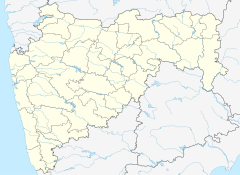Mahalakshmi Temple, Kolhapur
| Ambabai Temple of Kolhapur | |
|---|---|
 | |
| Religion | |
| Affiliation | Hinduism |
| District | Kolhapur |
| Deity | Mahalakshmi |
| Festivals | Kirnotsav, Rathotsav, Lakshmi Puja, Lalita Panchami, Navratri, Diwali, Varalakshmi Vratham |
| Governing body | Paschim Maharashtra Devasthan Samiti |
| Location | |
| Location | Bhavani Mandap, Mahadwar Road, Kolhapur |
| State | Maharashtra |
| Country | India |
Location in Maharashtra | |
| Geographic coordinates | 16°42′00″N 74°14′00″E / 16.70000°N 74.23333°E |
| Architecture | |
| Style | Hemadpanti architecture |
| Creator | Karnadeva, Chalukya Empire |
| Completed | 7th century CE |
| Website | |
| www | |
Mahalakshmi Temple (also known as Ambabai Mandir) is an important Hindu temple dedicated to Goddess Mahalakshmi, who resides here as Supreme Mother Mahalakshmi and is worshipped by locals as Ambabai. Goddess Mahalakshmi is the consort of Lord Vishnu and it is customary among Hindus to visit Tirumala Venkateswara Temple, Kolhapur Mahalakshmi Temple and Padmavathi Temple as a yatra (pilgrimage). It is believed that visiting these temples as a pilgrimage helps achieve moksha (salvation).[1]
Description
[edit]
The temple of the goddess Mahalakshmi was built by Karnadeva in 634 CE Chalukya reign.[2] Mounted on a stone platform, the murti of the crowned goddess is made of gemstone and weighs about 40 kilograms. The image of Mahalakshmi carved in black stone is 3 feet in height. The Shri Yantra is carved on one of the walls in the temple. A stone lion (the vahana of the goddess), stands behind the statue. The crown contains a five headed snake. Furthermore, she holds a Matulinga fruit, mace, shield and a pānapātra (drinking bowl). In Lakshmi Sahasranama of Skanda Purana, Goddess Lakshmi is praised as "Om Karaveera Nivasiniye Namaha" means "Glory to the Goddess who lives in Karaveera" and as "Om Sesha Vasuki Samsevyaa Namaha" means "Glory to Goddess who is served by Adi Sesha and Vasuki". They are the 119th and 698th names of Lakshmi in Lakshmi Sahasranama. This is also the description mentioned in the Rahasya of Devi Mahatmya.[3] Professor Prabhakar Malshe says, "The name of Karaveera is still locally used to denote the city of Kolhapur".[4]
History
[edit]The temple belongs architecturally to the Chalukya empire and was first built in the 7th century.[5] The temple is referred to in multiple Puranas. There is evidence to show that the Konkan king Kamadeo, Chalukyas, Shilahara, Yadavas of Devagiri dynasties visited this city. Adi Shankaracharya also visited.

In 109 CE, Karnadeo cut off the jungle and brought the temple to light. The existence goes back to the 8th century, according to Bhandarkar and Khare.[who?] Itihāsa Chakra indicates that the temple dates back to Mahājanapadā times. In the 8th century, the temple sank down due to an earthquake. In the 9th century, King Gandavadix extended the temple by building Mahakali Mandir. During 1178–1209, in the reign of Raja Jaysing and Sindhava, South gate and Atibaleshwar Temple were built. In 1218, Yadav king Tolum built Mahadwar and offered jewels to Devi. Furthermore, Shilaharas built Maha Sarasvati Mandir. He, being a Jain, got 64 idols carved. It is possible that a new idol called Padmavati was installed at that time. Historian Paul Dundas in his book The Jains[6] mentions that Mahalaxmi temple Kolhapur was a Jain temple.[7][8] Sheshashayee Vishnu which is an octagonal structure closer to the eastern gate has a panel of 60 Jain Tirthankaras carvings.[9][10] Jains worshipped the idol in the temple as Padmalaya or the abode of Padma or Padmavati, an epithet of Goddess Lakshmi.[11] Furthermore, in Chalukya times, Ganapati before the temple was installed. In the 13th century, Shankaracharya built Nagar Khana and Office, Deepmalas.
References
[edit]- ^ Stephen Knapp (1 January 2009). Spiritual India Handbook. Jaico Publishing House. p. 169. ISBN 9788184950243.
- ^ Amar Nath Khanna (2003). Pilgrim Shrines of India. Aryan Books International. p. 141. ISBN 9788173052385.
- ^ "Rahasya Thrayam I- Pradhanika Rahasyam - Hindupedia, the Hindu Encyclopedia". www.hindupedia.com. Retrieved 8 May 2021.
- ^ Prabhakar T. Malshe (1974). Kolhapur: A Study in Urban Geography. University of Poona. p. 3.
- ^ Tate, Karen (2005). Sacred Places of Goddess: 108 Destinations. CCC Publishing. p. 197. ISBN 9781888729177.
- ^ Dundas, Paul, 1952- (2002). The Jains (2nd ed.). London: Routledge. ISBN 0-203-39827-0. OCLC 252916273.
{{cite book}}: CS1 maint: multiple names: authors list (link) CS1 maint: numeric names: authors list (link) - ^ Dundas, Paul (2002). The Jains. Psychology Press. ISBN 978-0-415-26606-2.
- ^ Kumara Choudhry. The Jains Library of Religious Beliefs And Practices Paul Dundas Routledge.
- ^ "Inside Temples". mahalaxmikolhapur.com. Retrieved 28 May 2020.
- ^ Goyal, Anuradha (10 June 2019). "Mahalakshmi Temple - Jewel Among Kolhapur Temples". Inditales. Retrieved 28 May 2020.
- ^ "Jains - The Gazetteers Department - KOLHAPUR". Government of Maharashtra.
External links
[edit]- Mahalakshmi Temple in Kolhapur
 Media related to Mahalakshmi Temple, Kolhapur at Wikimedia Commons
Media related to Mahalakshmi Temple, Kolhapur at Wikimedia Commons





